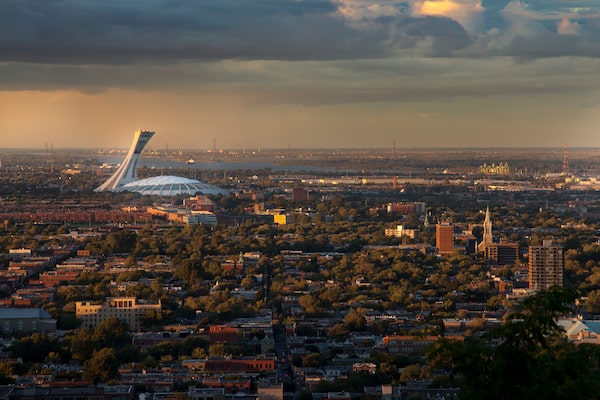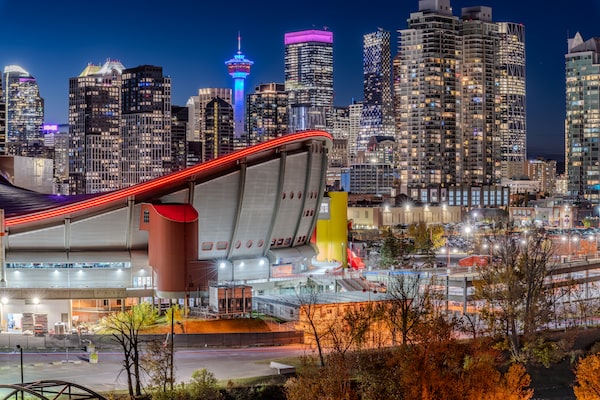
Canada’s three Olympic games each have wildly different reputations. City planners say committing to hosting must come with recognition of a building’s future uses.Getty Images
When cities commit to hosting the Olympics, they also commit to a huge construction bill.
With price tags that often hit billions of dollars, it’s up to cities to make this worth it. Many do so by ensuring the venues get reused well into the future.
Though there are high-profile exceptions, including facilities for the 2004 Athens Games and the 2016 Rio Games, 92 per cent of the permanent venues from recent Games – and 85 per cent from all modern-day Games – are still in use in some format, according to a 2022 report from the Olympic Studies Centre. Many venues for Canada’s three Olympic Games – in Montreal in 1976, Calgary in 1988 and Vancouver in 2010 – are among those. Some facilities, like the Whistler Sliding Centre built for the Vancouver Games, are still used today by amateur athletes. Others, such as the Richmond Olympic Oval and Canada Olympic Park, have been repurposed for public enjoyment.
But as marquee Olympic-era facilities including Montreal’s Olympic Stadium and Calgary’s Scotiabank Saddledome reach the end of their useful lifespan, former host cities have to make tough – and potentially expensive – choices that require balancing financial realities with Olympic legacies. Even in cities like Calgary, with a strong Olympic legacy, that balance is hard to find: the city’s residents rejected a potential 2026 hosting bid in 2018. Meanwhile, cities are increasingly learning to incorporate the use of existing facilities and plan for reuse of new ones when they develop bids to host the Olympics, offering lessons for host cities to come.
“Emotion and nostalgia are difficult to put a price on,” said Dr. Moshe Lander, a senior lecturer at Concordia University who focuses on sport economics. But it’s important to remember the cost of building or repairing venues suitable for Olympic competition has to come out of someone’s pocket, he said.
City Space podcast: Will the cost of hosting the FIFA World Cup pay off for Toronto?
Bid committees often sell citizens on becoming a host city by touting the financial benefits of bringing the Olympics to town – including access to funding for infrastructure improvements, an influx of tourists and a spotlight on the world stage. However, the financial benefits of these events are often overstated – and the risks often downplayed, Dr. Lander says.
The cost of hosting an Olympic Games has increased significantly over the past 50 years, with infrastructure costs landing as high as US$50-billion. Montreal’s 1976 Summer Games are heralded as an example of the financial risks for host cities. Building the Olympic Stadium left the city with more than $1-billion in debt, owing to a mix of mismanagement and corruption by Games officials and high inflation rates that hit the cost of essential materials like steel. This debt took 30 years to pay back.
And even the most successful venues have a useful lifespan – one Dr. Lander put at about 40 to 50 years. Both the Saddledome in Calgary and the Olympic Stadium in Montreal are near the end of that time period. Each city has taken a different approach to decommissioning their landmark venues as they age.
A building assessment done in 2018 found the Saddledome, which is currently used by sports teams including the Calgary Flames and large events like concerts, needed about $50-million in repairs over the coming decade just to continue operations. Last year, the City of Calgary announced a deal to construct a new arena and event centre that will serve as the home of the NHL’s Flames and other current sports tenants of the city’s Olympic-era arena.
In Quebec, the provincial government announced in February plans to spend $870-million to repair the roof of Montreal Olympic Stadium, despite its lack of a regular tenant and its otherwise-infrequent use for events such as concerts and trade shows. The government cited the stadium’s status as a cultural symbol among its justifications for spending the money to repair its aging roof, but critics, including Dr. Lander, say the costs aren’t worth it for a tenant-less venue of its age.
Large venues such as stadiums and arenas often become icons of a particular Olympic Games, but determining the legacy of a venue or of any particular event depends on the criteria used, said Dr. Angela J. Schneider, a professor at Western University and director of its International Centre for Olympic Studies. Someone focusing on the economic benefits or costs, for example, will view the legacy of a particular building differently than another person concerned with the human-rights impact, or the potential for the Games to inspire future athletes.

Calgary’s Scotiabank Saddledome is nearing the end of its useful lifespan.Gelu Popa/Getty Images
It’s important to remember that the Olympic Games affect far more than just the athletes who participate, Dr. Schneider said. That’s also true of the venues themselves, and the related infrastructure. Vancouver’s 2010 Olympic Games sped up necessary upgrades in the area’s mass transit and highway infrastructure, including improving the Sea-to-Sky highway and building the Canada Line between the airport and downtown. There were cheaper ways for the city to do this, Dr. Lander says, but the city’s successful bid for the Games got them done.
For Calgary, hosting the Games in 1988 paid off in terms of growth for the city – increasing its national and global profile. “This is one of those cases where it did put the city on the map,” Dr. Lander said. Many Olympic-era facilities built in Calgary were used by athletes for years after the Games, and some have credited that infrastructure with Canada’s development as a leading winter-sport nation in the decades since.
Key factors in ensuring former Olympic venues don’t become “white elephants” once the Games are over, according to a working paper published by Harvard Business School, include ensuring access to the site via mass transit, choosing a location apart from competing facilities and developing the area around the venue.
Venue considerations must also go beyond the building itself, or the costs of construction, some say. “Canadian cities contemplating Olympic bids must prioritize their residents’ well-being alongside any prospective economic gains,” said Dr. Stacy-Lynn Sant, an assistant professor of sport management at the University of Michigan school of kinesiology. That includes weighing social effects such as displacement of residents, discrimination and environmental degradation against the potential financial benefits.
Dr. Lander advocates for a rethinking of the Games themselves, suggesting a model that focuses on Olympic-level event competitions in cities that make sense for those sports – for example, hockey in Canada or speed skating in South Korea – and where appropriate facilities already exist.
Barring that, he pointed to Los Angeles’s upcoming 2028 Summer Games as an example of a good bid, thanks to the city’s existing first-class venues such as Los Angeles Coliseum, SoFi Stadium and Crypto.com Arena.
“If you’re going to make any money from the Olympics,” he says, “you’ve got to have the infrastructure in place.”